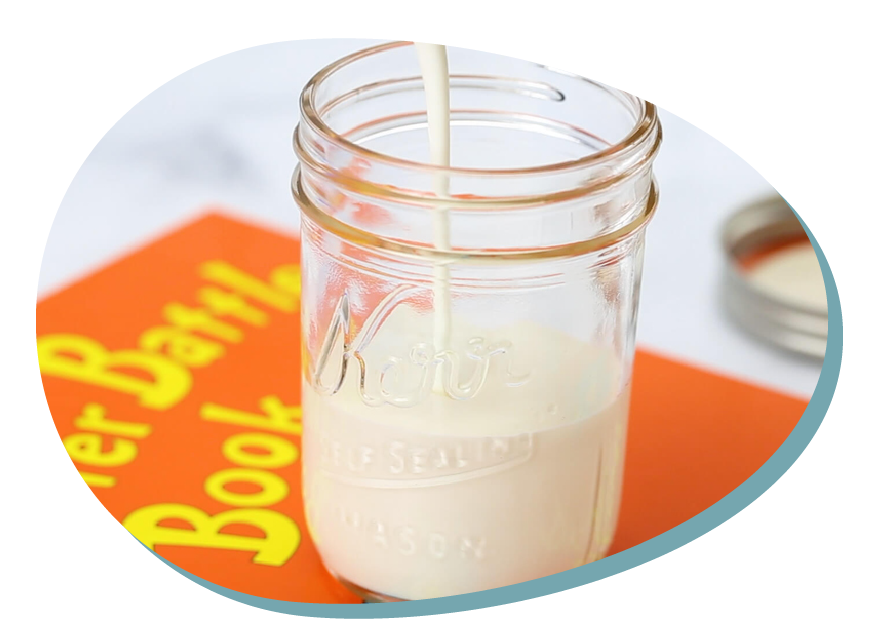Homemade butter in a jar
Type of resource: Web site, video, gidelines, animation
Web address https://littlebinsforlittlehands.com/how-to-make-butter-in-a-jar/
Language: English
Description
Experiment with heavy whipping cream to make butter.
Scientific concept introduced
Separation of fat molecules and water molecules.
Creative and critical thinking
To create recipes using the butter they made.
To guess other uses of the butter.
To explore the state changes of the butter in relation to temperature changes.
Mathematical reasoning
To count the minutes we will need to whipe and shake the cream to become butter.
To develop the ability to observe and discover.
Scientific thinking
To ask questions.
To analyze what is happening inside the jar.
To conduct a research, creating an hypothesis, predicting…
Learning how to learn
Coping with stress, ability to wait for their turn to shake the jar.
Additional
To share responsability of a task.
Homemade butter in a jar
Overall aims
To develop the ability to observe and discover.
To strengthen the research attitude of children.
To improve children’s problem-solving (take initiative).
To create the learning opportunity for explaining the concepts of Consistency, phisical reaction, appearance, taste, time, shaking, separation the solid of liquid;
Solution, air, cream, whipped, air pockets.
To use writing in a significant context.
Vocabulary – keywords should be understood
Consistency, phisical reaction, appearance, taste, time, shaking, separation the solid of liquid,
fat molecules, solution, air, cream, whipped, air pockets.
Expected learning outcomes (operational aims)
To run the experiment
To understand the phisical process of transformation the heavy whipping cream in butter
To explain the concepts of consistency, phisical reaction, appearance, taste, time, shaking, separation the solid of liquid, fat molecules, solution, air, cream, whipped, air pockets.
To shaking for about 20 minutes.
To strain the solid (butter) from the liquid (buttermilk).
STEM skills – to which the learning unit is related to
CORE STEM SKILLS
● Asking questions.
● Designing experiments.
● To test hypothesis
● Drawing conclusions based on results.
● Motivation to learn and engage.
● Self-discipline and self-regulated learning (cognitive autonomy).
ADDITIONAL SKILLS
Sharing ideas
Hand-eye coordination (shaking)
Literacy: writing
Teaching methodologies/activity outline
1- First fill your mason jar about 1/2 way with heavy whipping cream and put the cover on tightly!
Shaking for at least 15 minutes!
2- Ask questions such as: What is the consistency at the beggining? What could we do to see what happens in to the jar? What happens after 10 mintues shaking?
3- Ask the children to see the differences in appearance at the begging and in the end of the process.
4- Enjoy the delicious butter!
Assessment of learning
Initial evaluation
– Get to know the previous knowledge about this phisical reaction.
Continued evaluation
– Progressively acquire basic habits of autonomy in everyday actions, to act safely and effectively.
– Think, create, elaborate explanations and start the basic phisical and scientific skills.
– Observe and explore the immediate, natural and physical environment, with an attitude of curiosity and respect and gradually participate in social and cultural activities.
– Understand the necessity of norms, and specially safety rules
– Use words in an appropriate context and significatively
Final evaluation
– To evaluate the learning objectives, use the chart in which the more important elements will be highlighted.
Equipment and materials to be used in learning unit (tools, ingredients etc)
● Heavy whipping cream
● Mason jar with lid
● Salt (if you like in the butter)
● Book: The Butter Battle Book by Dr. Seuss
● Strainer
● Container or glass
Other: fresh bread, muffins, or another treat handy to spread butter after
Kind of setting
Kitchen, lab
References – source
https://littlebinsforlittlehands.com/how-to-make-butter-in-a-jar/
Homemade butter in a jar
1. Usefulness for STEM education – integrating content of different disciplines
Cross-curricular character of the resource

The range of S-T-E-M subjects included

The presentation of possibilities of including artistic activities (STEAM approach)

2. Expected learning outcomes
Consistency (links) with preschool core curriculum

Communicativeness of description

3. Methodology of teaching
Clarity, communicativeness of instructions for teachers

Meaningful learning – using practical life problems

Original idea

The level of ease in implementing the methodology to preschool age children

The level of ease in preparing necessary ingredients, materials and equipment needed

4. Sustainability
Ecological characteristics of materials/ results

Supporting healthy eating habits

Relation with local traditions of cooking (using local products)

Low ecological footprint

Possibilities of inclusion (respecting cultural diversity and food intolerances)

5. Class management
Using differentiated forms of work – individual, team work etc.

Individual work

Team work

Whole group
6. Time management

Short activity (10-15 minutes)

Medium activity (20-30 minutes)

Long activity (1 hour or more)

Very long activity (1 day or more)
PDF: https://www.printfriendly.com/p/g/gYmxMK

